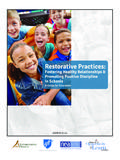Transcription of Quick Guide to Implementing a Peer Mediation …
1 Quick Guide toImplementing a peer Mediation Programby Richard CohenPeer Mediation : A form of conflict resolution in which trained student leaders help their peers work together to resolve everyday disputes. Participation in peer Mediation is voluntary, and with the exception of information that is illegal or life-threatening, all matters discussed in Mediation sessions remain confidential. Student mediators do not make judgments or offer advice, and they have no power to force decisions upon their peers. Because Mediation is sensitive to the underlying causes of conflict, the vast majority of peer Mediation sessions (@ 85%) result in lasting peer Mediation is one of the most popular and arguably the most effective approach to integrating the practice of conflict resolution into schools.
2 It is not hard to see why: peer Mediation encourages students to apply conflict resolution skills when it matters most when they are in conflict. By helping students resolve and learn from interpersonal disputes, peer Mediation programs also advance the educational mission of the schools in which they is the good news. Unfortunately, it is difficult to implement peer Mediation programs that live up to their potential. Many efforts falter from the start, and many more disappear after only a few years. What makes a program successful?
3 Just as plants require sunlight, air and water to thrive, three ingredients are essential for peer Mediation programs . They are:1. Enough Interpersonal Conflict To Warrant Initiating The ProgramIf mediators do not have the opportunity to mediate cases, few of the benefits associated with peer Mediation programs will be realized. Each school must determine what constitutes "enough conflict." Some programs handle only 20 cases a year, others mediate over 500. As a general rule, if your program won't mediate at least one case per week, then peer Mediation might not be the best fit for your Administrative SupportFor peer Mediation to succeed, administrators must work proactively to overcome attitudinal and structural resistance within their schools.
4 In particular, administrators in charge of discipline must be willing to make referrals and support student mediators' efforts. 3. A peer Mediation CoordinatorLike the coach to the basketball team, the conductor to the orchestra, the peer Mediation coordinator oversees all aspects of a peer Mediation program. The more resources this school-based adult has in terms of skill, commitment, and time during the school day, the more successful the program is likely to these three fundamentals are present in a school, chances are high that a strong Mediation program will result.
5 You can increase the likelihood of success still further by:a. helping to create a school philosophy and pedagogy which encourages students to take responsibility for their own education and work cooperatively with their integrating conflict resolution into the school through other avenues, including teacher training and in the general THE PROGRAM The process of Implementing a school-based Mediation program can be divided into four stages. They are: 1. Generating Initial SupportDuring this first stage program initiators hold meetings, conduct in-service workshops, deliver presentations (bringing experienced students and teachers from another school is especially effective), and distribute information packets/surveys in order to gain the support of key administrators and faculty.
6 Once your school has decided to implement a peer Mediation program, the most important task is to identify a coordinator. Coordinators can be vice-principals (but not disciplinarians), guidance counselors, teachers, special staff, and even community volunteers. Depending on the needs of the school and your program's resources, coordinators can work anywhere from full-time (the exception) to just one class period each day. It is also possible to have more than one individual "co-coordinate" a program. Responsibilities of the coordinator include: -handling in-school publicity and education of staff and students -overseeing the training of peer mediators-explaining Mediation to students in conflict and encouraging them to try it-scheduling Mediation sessions-supervising Mediation sessions-following up on all cases and maintaining records -keeping the school community informed about the program's progress2.
7 Planning and OutreachThe work of the second stage is usually the responsibility of the peer Mediation coordinator. Some coordinators form advisory committees (comprised of administrators, teachers, students and parents) to help formulate program policies and develop outreach strategies. Below are ten important questions that must be answered during this Will The Mediation Program Be Funded? Consider long term as well as short term financial needs, and try to arrange for funding for the first three years. Initial and on-going costs include coordinator's salary, training, substitutes for teachers participating in training, and miscellaneous expenses (books, paper, Xeroxing, t-shirts, etc.)
8 Sources of funding include school system budgets, private foundations and corporations, and federal, state and municipal grants dedicated to such things as school safety, prevention of drug and alcohol abuse, school improvement, drop-out prevention, desegregation, violence prevention, and teacher Students and Staff Will Be Trained To Mediate? The trainees should be a diverse group that represents a cross section of the school community. Consider ethnicity, race, religion, socio-economics, academics, clique, age, sexual orientation, etc.
9 Include some "at-risk" students in the training. Include key faculty who can help build support among their peers. Advertise using school newspapers, assemblies, public address announcements. Solicit recommendations from students, teachers and administrators. Interview trainees and look for commitment, personal ability, and availability to Will Conduct The peer Mediation Training? Only use trainers who have experience both as mediators and as trainers/teachers with the targeted age group. Look for trainers within your school system (school-based staff, health coordinators) or outside of your system (school Mediation training organizations, community Mediation programs , university programs , educators from neighboring schools).
10 Will The Training Be Scheduled? Resistance to pulling students from class is likely and understandable. Stress that as a result of the training, students improve their self-esteem and learn essential skills (communication, problem solving, critical thinking) that can be invaluable to their academic and personal success. (Research has clearly demonstrated that students perform better academically after they have been trained to be mediators.) Create a schedule that minimizes the time students miss any particular class.





